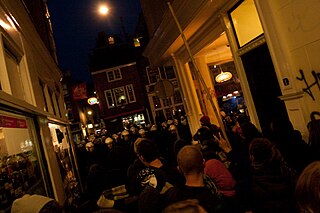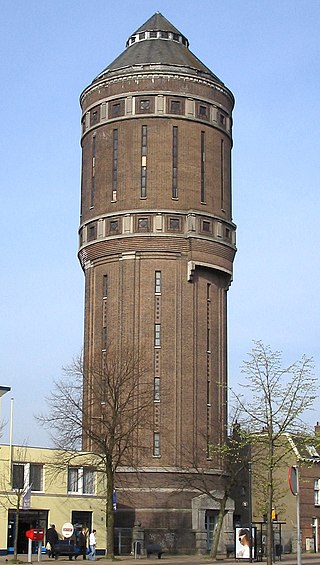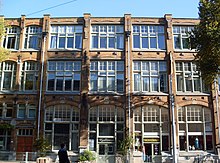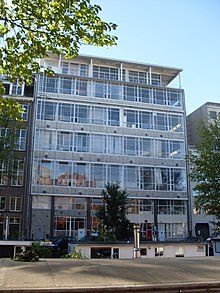The Dutch Sportsman and Sportswoman of the Year are chosen annually by Dutch athletes from a shortlist compiled by sports journalists. The elections are organized by the Dutch Olympic Committee. All the winners receive a Jaap Eden Award to remember their title.

Ruigoord is a village in the Houtrakpolder in the Dutch province of North Holland, situated within the municipality of Amsterdam. Until the 1880s, it was an island in the IJ bay, which was turned into a polder. In the 1960s, the municipality planned to extend the Port of Amsterdam. From 1972 onwards squatters occupied buildings and started a free zone. After resisting eviction in 1997, the area was legalized in 2000. The village is nowadays partially closed in by the port, and lies about 8 km east of Haarlem.

The Algemeen Nederlands Persbureau BV (ANP) is the largest news agency in the Netherlands. ANP was founded on 11 December 1934 by the association of Dutch newspapers (NDP). The news agency's founders sought to produce a fast, fair and accurate alternative to the existing commercial news agencies. In 2021, management decided start using gender neutral wording.

The Dutch squatting ban refers to the law introduced on 1 October 2010, under which squatting in the Netherlands became de jure illegal. Criminalization had first been proposed in the 1970s, but was opposed by the Council of Churches. In 2006, a new plan was proposed and backed by parties including VVD and PVV. When the new law was introduced, squatters occupied the former head office of the fire brigade and there were riots in Amsterdam and Nijmegen. In 2011, the Supreme Court of the Netherlands ruled that the legally forced end of squatting can only occur after an intervention of a judge. Between October 2010 and December 2014, 529 people were arrested for the act of occupying derelict buildings, in 213 separate incidents as a result of which 39 people were jailed.

Hanneke Groenteman is a Dutch journalist, radio broadcaster and television presenter who tends to focus on culture-related topics.
Mimoun "Simon" Ouaali is a Moroccan–Dutch football manager. He has coached Chabab Rif Al Hoceima in Morocco and VVZ '49, Sparta Nijkerk, SV Argon and DVS' 33 in the Netherlands. Ouaali received the Rinus Michels Award after the team he managed, Sparta Nijkerk, won a championship in the Hoofdklasse. His younger brother, Saïd Ouaali, was head of the Ajax Youth Academy until July 2023.

Jimmy Joy is a Dutch meal replacement company. The company was founded in 2014 by Joey van Koningsbruggen. Soylent was not yet available in Europe, so van Koningsbruggen bought the ingredients himself and vlogged about it on YouTube, which gained him the initial customer base. Nine months later, the company had revenues of over $200,000 per month, and sold to 45 countries. The company was formerly known as Joylent, but agreed to change its name in February 2017 after Soylent asked them to. Its customers mostly consist of young men, some of whom rely exclusively on Jimmy Joy shakes as their main source of nutrition. Germany and the U.K. are its biggest export markets. By March 2018, the company had sold over 7.5 million shakes online, and was being sold by supermarket chains Albert Heijn and Spar.

We Are Here is a collective of migrants based in Amsterdam, the Netherlands, which campaigns for human rights for its members and all undocumented migrants. The asylum seekers have in many cases had their applications to remain in the Netherlands denied but they either cannot go back or refuse to return to their country of origin. They demand access to social services such as medical care and housing. The group formed in 2012 and by 2015 contained over 200 migrants from around 15 countries.

Vrankrijk is a legalised squat and self-managed social centre on the Spuistraat in central Amsterdam. There is an events space on the ground floor and above it a separate housing group.

Squatting in the Netherlands is the occupation of unused or derelict buildings or land without the permission of the owner. The modern squatters movement began in the 1960s in the Netherlands. By the 1980s, it had become a powerful anarchist social movement which regularly came into conflict with the state, particularly in Amsterdam with the Vondelstraat and coronation riots.

The Dutch Furniture Awards is a former annual furniture design competition in the Netherlands, organized from 1985 to 1998. This was an initiative of the Jaarbeurs Utrecht and the Vereniging van Vakbeurs Meubel (VVM).
Ecotribe Teuge is a collective of people living on a squatted terrain in the Dutch countryside. It is located on the edge of the village of Teuge, in the province of Gelderland. The buildings were constructed by the Nazis and formerly used to house Moluccan soldiers. The site was occupied in 2001, when people began to live there in an off-the-grid and self-sufficient manner. Since 2018, there are plans by the province to develop the terrain.

The Tabakspanden are a group of buildings standing on the Spuistraat in central Amsterdam, adjacent to the Keizerrijk and Wijdesteeg alleyways. Named after a former owner, the speculator Hendrik Tabak, they were mostly squatted from 1983 onwards, although the artist Peter Klashorst also rented an apartment and gallery space. The best known building was Spuistraat 199, known as the Slangenpand (Snakehouse) because of the large mural which covered the front exterior. In 2015, the squatters were evicted and the buildings were mostly demolished prior to redevelopment. The new project is known as De Keizer and has 69 apartments, a restaurant and a gallery. Two of the buildings are registered as rijksmonumenten.

Beau van Erven Dorens is a Dutch television presenter, actor and voice actor. He is known for presenting many television programs, including Deal or No Deal, RTL Boulevard, Het Zesde Zintuig and Beau Five Days Inside.

De Vloek was a squatted, self-managed social centre in The Hague, the Netherlands, between 2002 and 2015. Located on Hellingweg 127 in Scheveningen, beside the North Sea, the squat hosted workplaces, living spaces, a venue, and a vegan restaurant. The local council tolerated the occupation until 2014, when it decided to sell the building. A political struggle over the eviction began; some political parties supported the squatters and the Scheveningen Pier was briefly occupied as a protest action. A deal was made for the squatters to move to a former school building and the Vloek was eventually evicted in September 2015.

The Ubica buildings are two adjacent buildings standing at 24 and 26 Ganzenmarkt, in central Utrecht, the Netherlands. Number 24 is a rijksmonument. The first recorded mention of the buildings is from 1319. After centuries of residential use, the buildings were bought by the Ubica mattress company in 1913 and used until a devastating fire in 1989. The buildings were then squatted for 21 years, before being redeveloped into a hotel and café-restaurant in 2014.

The Amsterdamsestraatweg Water Tower is located in Utrecht, the Netherlands. The water tower was built at Amsterdamsestraatweg 380 in 1916, in the style of the Amsterdam School. It became derelict in 1986 and was repeatedly squatted before its redevelopment into apartments began in 2020.
Maria Johanna Francisca Renée "Noni" Lichtveld was a Dutch-Surinamese author, illustrator and scenic designer.
Op de Valreep was a squatted building in Amsterdam, the Netherlands. Occupied in 2011, the former animal shelter was converted into a self-managed social centre. The squatters resisted eviction with creative actions, such as pretending the council had given them ownership and making spoof election materials. They were forcibly removed in 2014; the building was later converted into a restaurant.

The Wyers squat was a self-managed social centre on Nieuwezijds Voorburgwal in central Amsterdam, the Netherlands, between 1981 and 1984. The buildings of the Wyers former wholesale textile company were converted by the squatters into a range of living and work spaces. When the Government of Amsterdam decided to demolish the complex to make way for a Holiday Inn hotel, a car parking garage and apartments, the squatters made alternative proposals. The eviction was announced for February 14 1984 and there were demonstrations in support of the squat around the country. On the day of eviction, 1,500 people stayed inside the building then left without conflict. The breeding place discourse of new cultural initiatives presented by the squatters was later adopted by the city council.


















